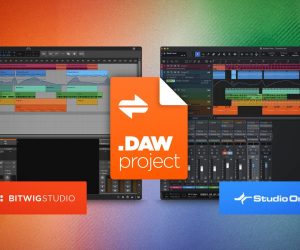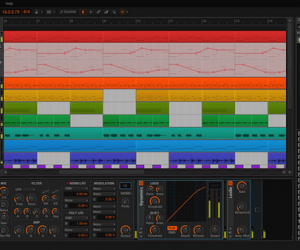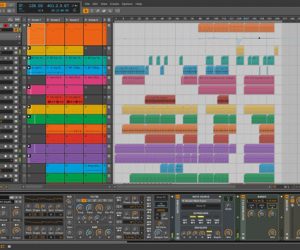
Bitwig Studio 4
Bitwig Studio 4 is here and comes with a new sound package: Anti-Loops; new comping features and “Operators”
Bitwig Studio’s latest update saw the arrival of comping for audio clips and Operators for all sequenced events. Anti-Loops uses these features to push the idea of what a loop is to the breaking point. Because after all, maybe the best loops don’t.
Get lost in the ever-changing landscape of somewhat-unpredictable, sometimes-irregular and always-interesting “Anti-Loops.” The Anti-Loops package consists of 100+ clips with sequenced notes and audio that utilise comping and Operators in creative ways. Operators for notes and audio events allow for boundless musical diversity and change, and the specially prepared comping clips hold hidden variations for you to discover. Expert sound designers like Cristian Vogel, Polarity and Pat Cupo crafted these sounds to be added into any track or used as a first element to get your project started. When something arhythmic becomes rhythmic, or when a looping element feels a little variable and almost broken — that’s something worth building a track on.
So much more than flat WAVs, the Anti-Loops clips are ready to be edited and reworked as much or as little as you like. Use the Anti-Loops clips to learn, as inspiration, or as starting points for your own musical journeys.
Anti-Loops is available for all Bitwig Studio customers with an active Upgrade Plan. Download it now in the Dashboard under “Packages.”
With Bitwig Studio version 4 new musical timelines have arrived.
This means comping for audio clips, both in the Clip Launcher and the Arranger. A new set of Operators for changing the chance, recurrence and more of any note or audio event. Random Spread for any expression point (like per-note pitch or audio panning). Bitwig Studio 4 has native Apple Silicon support on Mac and even allows Intel and ARM plug-ins to work side-by-side.
Key Features:
Since the invention of studio recording, the task of engineers has been to create the perfect performance. Comping allows you to combine the best parts of many takes, and Bitwig Studio provides this and more.
Each take is given its own colour, so the sources are clear from the first swipe of a take lane. Different takes can be swapped in with a tap. Then press the up or down arrow to cycle through the other takes. From the composite lane, move a boundary by clicking, adjust gain by dragging, or fix timing by sliding.
Since a Launcher and an Arranger already exist, comping lives instead inside the audio clip. So if composing in the Launcher, click to enable comp recording right there. Or drag clips in either direction with takes safely inside. You can even open the layered editor when multiple comps belong together. Comping works wherever you are, now and later.
And since all good techniques deserve a new trick, right-click any audio clip to Fold To Takes. If you ask for an eight-bar comp, the entire clip will be spooled into take lanes, and the comping can begin. Or just drag audio in to add a new take lane. The stranger the sources, the newer the result.
Operators
Modulation has always been a centrepiece of Bitwig Studio. Modulators have been there all along, putting device parameters into motion. And now with Operators, sequenced note and audio events can become electric too. Operators allow you to take sequenced events and animate them with randomness, cycle-aware logic, performance controls, and other interrelationships that expand what a clip is capable of. Operators also empower you to go to different possibilities and timelines, either by programming or by performance control.
Operators include four modes, which can be used individually or in any combination:
- Chance makes each event more or less likely.
- Repeats allow each event to retrigger at a set rate or divide the note length into any number of pieces, with ramp-able timing. And a Slice At Repeats option is available to print out the individual events.
- Occurrence sets conditions for each event, like: Is this the first loop of the clip or not? Is the performance-control Fill button turned on? Or did the previous event play, or was it silent?
- Recurrence thinks of each event as its own looping timeline. So pick a cycle length (say, every four loops of the clip), and then check off whether the event plays on each of those four passes.
- Add it all up and what do you get? How about a steady stream of 16th notes each with a 50% chance, producing a consistently different rhythm each time. Or a cymbal on beat 1 that plays every fourth clip repeat and never on the first trigger. Maybe connecting two notes so that either the first one plays or the second, but never both. Or maybe you use repeats to create audio polyrhythms, or to simply “ratchet” a single note into dozens of retriggered events with a timing ramp.
And when you need to take your chances on something certain, you can Expand a clip, printing out two, 20, or however many cycles of the original as a new clip. This lets you see all the nested patterns and relationships that Operators can bring to a “simple” loop, or even start a precise edit without the randomness. Putting down the dice is an equally valid choice.
Expression Spread
Bitwig’s engine uniquely allows Expression automation for notes and audio. And since randomness was in the air, a visualized Spread range is now available on any expression point. You can add randomisation to note velocities, and give each piece of a chord its own panning. Or create a note that starts in tune and then drifts to a random pitch. Or give each slice of an audio clip a slightly randomised gain.
With the editor open, all destined random values are visualised when the clip starts. And then again, the new values appear when the next loop cycle begins. When the interface and sound is this tightly connected, you’ve harnessed the chaos and can just make music.
You can even cast the dice yourself by clicking the Seed field of any clip. If you like what you hear, that same “random” pattern is now locked in for all Spread parameters — and any events with a Chance Operator.
Native on Apple Silicon
When new computers arrive, software must follow. Apple is making their own M1 processors, so now Bitwig Studio runs natively on Apple Silicon.
Some more good news is that your Intel and ARM VSTs can live alongside each other. Bitwig Studio has always handled plug-ins differently, hosting them separately from the DAW. Because if a plug-in has to crash, it is better that Bitwig Studio keeps playing. Now this means mixing VST architectures as well, and just as safely.
Each platform is different, and we support three of them. So whether it is Apple Silicon, a full multitouch interface for Windows and Linux, or native CV and MPE support for everyone, Bitwig Studio is the DAW that connects all these technologies
And Then Some
- Bitwig Studio is now localised in Chinese, Japanese, and German. The interface remains the same, but functions, labels, and in-app documentation — including the Interactive Help for our 300+ devices and modules — can be displayed in any of these languages.
- A new Globals Modulator. Since Operators have a performance angle, the new Globals modulator came along as well, providing the current value of the Fill button, the position of the global crossfader, and more. Because while per-note control is fantastic, so is assigning a couple global controls to all of your tracks.
- Improved export options. No matter which editing tools and devices you use, it all becomes audio in the end. With version 4, our export options have improved, allowing you to select from lossless formats (WAV & FLAC), familiar lossy options (OGG & MP3), and a new contender (OPUS). So select part of your arrangement and bounce it to one or more formats. Or pick your top-level group tracks to export stems.
- New import options. Chances are you have more than one music program on your computer. (We do.) So on the import side, you can now import data from your FL Studio (FLP) and Ableton Live (ALS) files into Bitwig. Your clips and arrangements should make it over pretty cleanly, as well as VST plug-ins.
- And some other improvements have come along too. Content sliding (and gain handles for audio) is available directly at the clip and event level with visual handles that appear while you work. To make audio easier to read, waveforms are now shown in a Perceptual scale (or switch back to Linear in the Dashboard). And most of our Grid and Polymer filters have a smoother response now for extreme resonance and modulation cases.
Availability
Bitwig Studio 4 is out now and it is a free upgrade to everyone with an active Upgrade Plan for Bitwig Studio. All new features except comping are also part of Bitwig Studio 16-Track and 8-Track.
















RESPONSES